人教版高中英语教学设计
- 格式:doc
- 大小:9.37 KB
- 文档页数:4
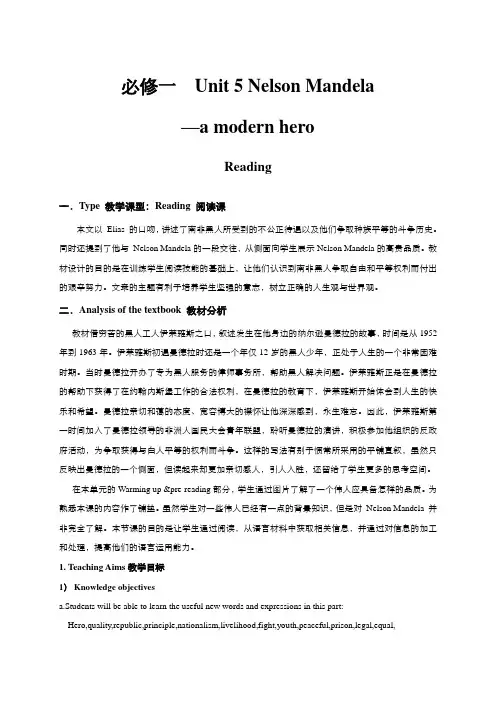
必修一Unit 5 Nelson Mandela—a modern heroReading一.Type 教学课型:Reading 阅读课本文以Elias 的口吻,讲述了南非黑人所受到的不公正待遇以及他们争取种族平等的斗争历史。
同时还提到了他与Nelson Mandela的一段交往,从侧面向学生展示Nelson Mandela的高贵品质。
教材设计的目的是在训练学生阅读技能的基础上,让他们认识到南非黑人争取自由和平等权利而付出的艰辛努力。
文章的主题有利于培养学生坚强的意志,树立正确的人生观与世界观。
二.Analysis of the textbook 教材分析教材借穷苦的黑人工人伊莱雅斯之口,叙述发生在他身边的纳尔逊曼德拉的故事,时间是从1952年到1963年。
伊莱雅斯初遇曼德拉时还是一个年仅12岁的黑人少年,正处于人生的一个非常困难时期。
当时曼德拉开办了专为黑人服务的侓师事务所,帮助黑人解决问题。
伊莱雅斯正是在曼德拉的帮助下获得了在约翰内斯堡工作的合法权利,在曼德拉的教育下,伊莱雅斯开始体会到人生的快乐和希望。
曼德拉亲切和蔼的态度、宽容博大的襟怀让他深深感到,永生难忘。
因此,伊莱雅斯第一时间加入了曼德拉领导的非洲人国民大会青年联盟,聆听曼德拉的演讲,积极参加他组织的反政府活动,为争取获得与白人平等的权利而斗争。
这样的写法有别于惯常所采用的平铺直叙,虽然只反映出曼德拉的一个侧面,但读起来却更加亲切感人,引人入胜,还留给了学生更多的思考空间。
在本单元的Warming up &pre-reading部分,学生通过图片了解了一个伟人应具备怎样的品质。
为熟悉本课的内容作了铺垫。
虽然学生对一些伟人已经有一点的背景知识,但是对Nelson Mandela 并非完全了解。
本节课的目的是让学生通过阅读,从语言材料中获取相关信息,并通过对信息的加工和处理,提高他们的语言运用能力。
1. Teaching Aims教学目标1)Knowledge objectivesa.Students will be able to learn the useful new words and expressions in this part:Hero,quality,republic,principle,nationalism,livelihood,fight,youth,peaceful,prison,legal,equal,law,advise,continue,gold,passbook,ANC,league,stage,vote,position,accept,violence,devote,vote, guidance, blow up, in troubleb. Enable the students to read Elias’ storyc. Guide the students to know the qualities of Nelson Mandela as a great leader2) Ability objectivesa.Develop the students ’reading skills, such as fast reading ,careful reading and summarizingb.Improve the students’ comprehension ability3) Emotion objectivesa,Understand the qualities great person have in common and learn the fine qualities from themb.Develop the students’ moral quality2.Teaching important points教学重点a.Enable the students to read Elias’ story and Learn to grasp the main idea of the text.b.Enable students to talk about the fine qualities of great people,especially Nelson Mandelac.Improve the students’ reading ability3.Teaching difficult points 教学难点a.How to grasp the main idea of the text.b.How to help develop students’ reading abilityc.How to help students learn from Nelson Mandela4.Teaching methods 教学方法a.Student-centeredb.Task-based teaching method(任务型教学)c.Discussion5.Learning methods 学习方法Individual or pair work and group work6.Teaching Aids 教具准备The multimedia三.教学设计1. 总体思路本堂课的主要内容分为四大部分,Pre-reading(阅读前活动) ,while –reading(阅读中活动),post-reading(阅读后活动)以及discussion(讨论) and role play 。
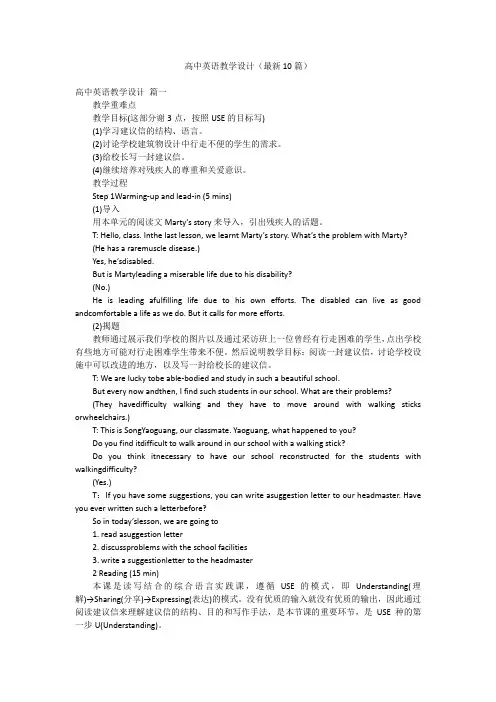
高中英语教学设计(最新10篇)高中英语教学设计篇一教学重难点教学目标(这部分谢3点,按照USE的目标写)(1)学习建议信的结构、语言。
(2)讨论学校建筑物设计中行走不便的学生的需求。
(3)给校长写一封建议信。
(4)继续培养对残疾人的尊重和关爱意识。
教学过程Step 1Warming-up and lead-in (5 mins)(1)导入用本单元的阅读文Marty’s story来导入,引出残疾人的话题。
T: Hello, class. Inthe last lesson, we learnt Marty’s story. What’s the problem with Marty?(He has a raremuscle disease.)Yes, he’sdisabled.But is Martyleading a miserable life due to his disability?(No.)He is leading afulfilling life due to his own efforts. The disabled can live as good andcomfortable a life as we do. But it calls for more efforts.(2)揭题教师通过展示我们学校的图片以及通过采访班上一位曾经有行走困难的学生,点出学校有些地方可能对行走困难学生带来不便。
然后说明教学目标:阅读一封建议信,讨论学校设施中可以改进的地方,以及写一封给校长的建议信。
T: We are lucky tobe able-bodied and study in such a beautiful school.But every now andthen, I find such students in our school. What are their problems?(They havedifficulty walking and they have to move around with walking sticks orwheelchairs.)T: This is SongYaoguang, our classmate. Yaoguang, what happened to you?Do you find itdifficult to walk around in our school with a walking stick?Do you think itnecessary to have our school reconstructed for the students with walkingdifficulty?(Yes.)T:If you have some suggestions, you can write asuggestion letter to our headmaster. Have you ever written such a letterbefore?So in today’slesson, we are going to1. read asuggestion letter2. discussproblems with the school facilities3. write a suggestionletter to the headmaster2 Reading (15 min)本课是读写结合的综合语言实践课,遵循USE的模式,即Understanding(理解)→Sharing(分享)→Expressing(表达)的模式。
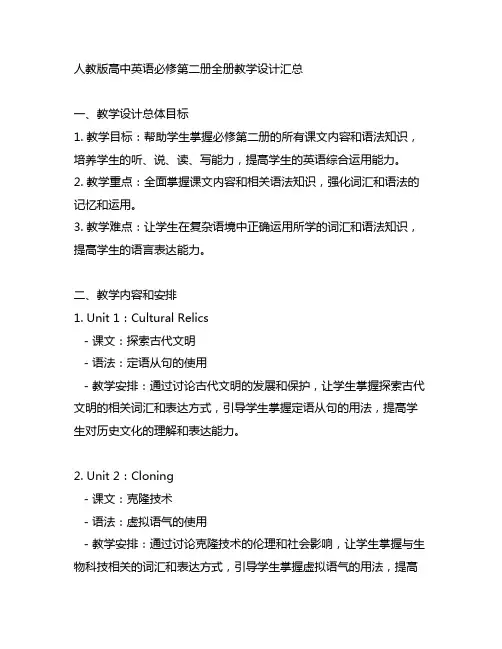
人教版高中英语必修第二册全册教学设计汇总一、教学设计总体目标1. 教学目标:帮助学生掌握必修第二册的所有课文内容和语法知识,培养学生的听、说、读、写能力,提高学生的英语综合运用能力。
2. 教学重点:全面掌握课文内容和相关语法知识,强化词汇和语法的记忆和运用。
3. 教学难点:让学生在复杂语境中正确运用所学的词汇和语法知识,提高学生的语言表达能力。
二、教学内容和安排1. Unit 1:Cultural Relics- 课文:探索古代文明- 语法:定语从句的使用- 教学安排:通过讨论古代文明的发展和保护,让学生掌握探索古代文明的相关词汇和表达方式,引导学生掌握定语从句的用法,提高学生对历史文化的理解和表达能力。
2. Unit 2:Cloning- 课文:克隆技术- 语法:虚拟语气的使用- 教学安排:通过讨论克隆技术的伦理和社会影响,让学生掌握与生物科技相关的词汇和表达方式,引导学生掌握虚拟语气的用法,提高学生对科技进步的理解和表达能力。
3. Unit 3:Travel Journal- 课文:游记- 语法:名词性从句的使用- 教学安排:通过学习游记的写作技巧和语言表达,让学生掌握与旅行相关的词汇和表达方式,引导学生掌握名词性从句的用法,提高学生对旅行经历的表达能力。
4. Unit 4:Wildlife Protection- 课文:野生动物保护- 语法:情态动词的使用- 教学安排:通过探讨野生动物保护的挑战和方法,让学生掌握与环保相关的词汇和表达方式,引导学生掌握情态动词的用法,提高学生对环保议题的理解和表达能力。
5. Unit 5:Music- 课文:音乐- 语法:定语从句和名词性从句的复合句- 教学安排:通过学习不同类型音乐的特点和音乐家的成就,让学生掌握音乐方面的词汇和表达方式,引导学生掌握定语和名词性从句的复合句结构,提高学生对音乐艺术的理解和表达能力。
6. Unit 6:Language- 课文:语言- 语法:宾语从句和名词性从句的区别及使用- 教学安排:通过探讨不同语言的重要性和影响,让学生掌握与语言学习相关的词汇和表达方式,引导学生区分宾语从句和名词性从句的使用,并正确运用它们,提高学生对语言学习的理解和表达能力。
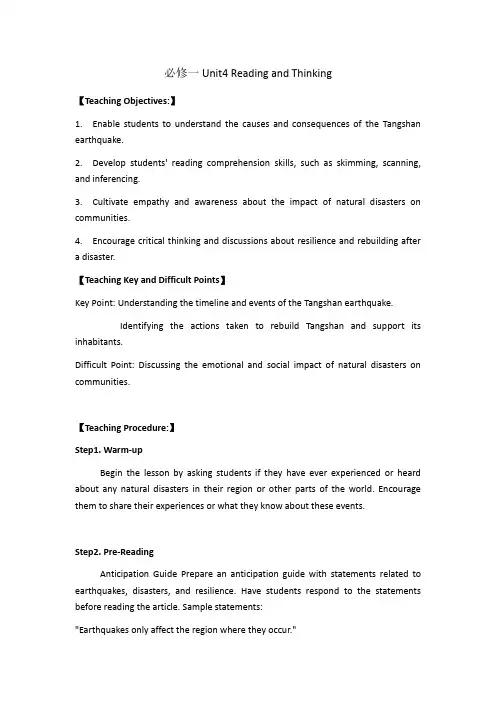
必修一Unit4 Reading and Thinking【Teaching Objectives:】1.Enable students to understand the causes and consequences of the Tangshan earthquake.2.Develop students' reading comprehension skills, such as skimming, scanning, and inferencing.3.Cultivate empathy and awareness about the impact of natural disasters on communities.4.Encourage critical thinking and discussions about resilience and rebuilding aftera disaster.【Teaching Key and Difficult Points】Key Point: Understanding the timeline and events of the Tangshan earthquake.Identifying the actions taken to rebuild Tangshan and support its inhabitants.Difficult Point: Discussing the emotional and social impact of natural disasters on communities.【Teaching Procedure:】Step1. Warm-upBegin the lesson by asking students if they have ever experienced or heard about any natural disasters in their region or other parts of the world. Encourage them to share their experiences or what they know about these events.Step2. Pre-ReadingAnticipation Guide Prepare an anticipation guide with statements related to earthquakes, disasters, and resilience. Have students respond to the statements before reading the article. Sample statements:"Earthquakes only affect the region where they occur.""Rebuilding after a disaster is an impossible task.""People's unity is essential in overcoming a disaster."After the article is read, revisit the statements to discuss whether their opinions have changed.Step3. While-ReadingActivity 1: Visualizing the SceneDisplay a picture of the Tangshan earthquake aftermath, and ask students to describe what they see. Prompt them to visualize the impact and destruction caused by the earthquake.Activity 2: Comprehension QuestionsDivide the class into groups and provide each group with a set of comprehension questions related to the article. Example questions:What time did the earthquake occur?How many people were estimated to be dead or injured?How did the government and volunteers help Tangshan recover? Encourage students to refer back to the article for answers and discuss their responses within their groups.Activity 3: Cause and EffectHave students identify the causes and effects of the Tangshan earthquake. Discuss as a class how natural disasters can have far-reaching consequences and how communities respond in the aftermath.Step4. Post-ReadingActivity 1: Survivor StoriesAsk students to imagine they were survivors of the Tangshan earthquake. In small groups, they can create short narratives from the perspective of different individuals who experienced the disaster. Encourage creativity and empathy in their storytelling.Activity 2: Disaster PreparednessPoster Divide the class into teams and assign each team a specific natural disaster (e.g., earthquake, flood, hurricane). Have the teams create informative posters that highlight safety tips and preparation measures for that particular disaster.HomeworkAsk students to research and write a short essay on a different natural disaster that occurred in a different part of the world, discussing its impact on the community and how people responded to rebuild and recover.。
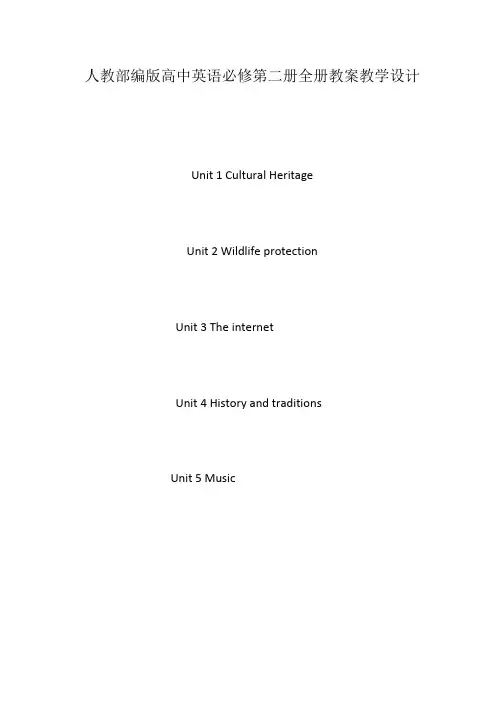
人教部编版高中英语必修第二册全册教案教学设计Unit 1 Cultural HeritageUnit 2 Wildlife protectionUnit 3 The internetUnit 4 History and traditionsUnit 5 MusicUnit 1 Cultural HeritagePeriod 2 Reading and Thinking:From Problems to Solutions【教材分析】1.This section focuses on "Understanding how a problem was solved,,, which is aimed to guide students to analyze and discuss the challenges and problems faced by cultural heritage protection during the construction of Aswan Dam, as well as the solutions. On the basis of understanding, students should pay attention to the key role of international cooperation in solving problems, and attach importance to the balance and coordination between cultural heritage protection and social and economic development. Students are encouraged to face challenges actively, be good at cooperation, and make continuous efforts to find reasonable ways and means to solve problems.【教学目标】1.Enable students to understand the main information and text structure of the reading text;2.Motivate students to use the reading strategy "make a timeline,, according to the appropriate text genre;3.Enable students to understand how a problem was solved;4.Enable students to understand the value of protecting cultural heritage by teamwork and global community;【教学重难点】1.Guide students to pay attention to reading strategies, such as prediction, self-questioning and scanning.2.Help students sort out the topic language about protecting cultural relics and understand the narrative characteristics of "time-event" in illustrative style3.Lead students to understand the value of protecting cultural heritage by teamwork and global community;【教学过程】1.PredictionStep 1 Predicting the main idea of the passageLook at the title and the pictures, and then predict what the passage will be about.Q: What will be talked about?Step 2: Fast reading tasksTask of the first fast reading:Read quickly and figure out the key words of each paragraph.•Paragraph 1: challenge•Paragraph 2: proposal led to protests•Paragraph 3: committee established•Paragraph 4: brought together•Paragraph 5: success•Paragraph 6: spiritTask of the second fast reading:1.Why did the Egyptian government want to build a new dam in the 1950s?2.Why did the building of the dam lead to protests?3.How did the government save the cultural relics?4.Which one can describe the project?A. Successful.B. Negative.C. Useless.D. Doubtful.5.What can be learned from the Aswan Dam project?Step 3: Careful reading tasksRead more carefully and answer the following questions.1.What do "problems" refer to and what do "solutions" refer to?2.Find out the numbers in paragraph four and explain why the author used exact numbers instead of expressions like many?3.What can you infer from "Over the next 20 years, thousands of engineers and workers rescued 22 temples and countless cultural relics"?4.What can you infer from "Fifty countries donated nearly 80 million to the project"?The project cost a lot of money.5.Before the building of the dam, what problems did the Nile River bring to the Egyptian?6.What words can you think of to describe the working process of the project?Step 4: ConsolidationDivide the passage into three parts and get the main idea of each part.Part 1 (Paragraph 1)The introduction of the topicKeeping the right balance between progress and the protection of cultural sites is a big challenge.Part 2 (Paragraphs 2-5)The process of saving cultural relics•Big challenges can sometimes lead to great solutions.•The Egyptian government wanted to build a new dam, which would damage many cultural relics.•The government turned to the UN for help.•Experts made a proposal for how to save cultural relics after a lot of efforts and the work began.•Cultural relics were taken down and moved to a safe place.•Countless c ultural relics were rescued.•The project was a success.Part 3 (Paragraph 6)The summary of the textThe global community can sometimes provide a solution to a difficult problem for a single nation.Step 5: Critical thinking:1.How to deal with the construction and the protection of cultural relics?2.As students, what should we do to protect our cultural relics?Step 6: summaryStep 7 Homework:Review what we have learned and find out the key language points in the text. 板书设计教学反思Unit 2 Wildlife ProtectionReading for Writing【教材分析】The activity theme is "making effective poster,,. The protection of wildlife needs the participation of the whole society. It is imperative to educate the public on wildlife protection and arouse the public's awareness and enthusiasm for wildlife protection. Teenagers are not only the main body of education, but also the "ambassador" of publicity and promotion. To make posters, students need to understand and study the situation of endangered animals and think about protection measures. In the process of reading and understanding the content of posters and making posters, students should be trained to master and use the style of posters, and their social responsibility and sense of responsibility should be cultivated.The reading text is two posters. The first poster, "give ugly a chance!" calls on people to protect all kinds of wild animals and not treat them differently because of personal likes and dislikes. No matter how beautiful or ugly animals are, they have the meaning and value of existence. The world is beautiful because of the diversity of biology. The article uses the tone of statement to make people unconsciously accept the author's point of view. The second POSTER "don't make paper with my home!,, adopts anthropomorphic rhetoric and takes koala's heart cry as the title, criticizing those behaviors of deforestation and destruction of animal homes. The text is a progressive explanation of the title. Exclamatory sentences and rhetorical sentences are used in this paper, which express the author's attitude and point of view. In addition, the title ofthese two posters uses exclamation sentences with strong appeal and emotional color, coupled with vivid pictures, making the posters more powerful.【教学目标】1.Cultivate students to acquire some features about an English poster by reading the text.2.Help students to write an English poster about animal protection properly using some newly acquired writing skills in this period.3.Develop students' writing and cooperating abilities.4.Strengthen students' great interest in writing discourses.【教学重难点】1.Stimulate students to have a good understanding of how to write an English poster properly.2.Cultivate students to write an English poster properly and concisely.【教学过程】Step 1: Lead inDo you want to be a volunteer of a pefs shelter? Why?Yes, I want to be a volunteer of it, because I want to help the pets, which are lovely and cute. I like them very much.Step 2: Read to discover details concerning the main details of the news report.I.Read the news report and then solve the questions below.1.Who started the rescue centre called the Small Friends Pet Shelter?A group of high school students and parents.2.What did the young people do in the shelter?Take care of animals.3.How do the young people think of their work?Worthwhile4.What help does the centre need?Volunteers, time and love.II. Read the text again and then choose the best answer.1.What should we do when we protect the wildlife animals?A.Treat all the wild animals equally.B.Only pay attention to less cute animals.C.Pay attention to cute animals.D.Care about endangered wildlife animals.2.Whafs the bad effect of cutting down billions of trees to make paper for humans?A.Make a lot of animals homeless.B.Make a number of wildlife animals dying out.C.The animals5 habitat is being destroyed.D.All of them.【答案】ADCStep 3: Study the organization and language features.1.Read the passage more carefully and write down the outline of the text.1.The Small Friends Pet Shelter was started by a group of high school students and their parents when they started to see many pets (that were left behind after their families moved away).译文:当一些高中生和他们的父母看到在主人搬走后,时,们建立了小朋友宠物收容所。
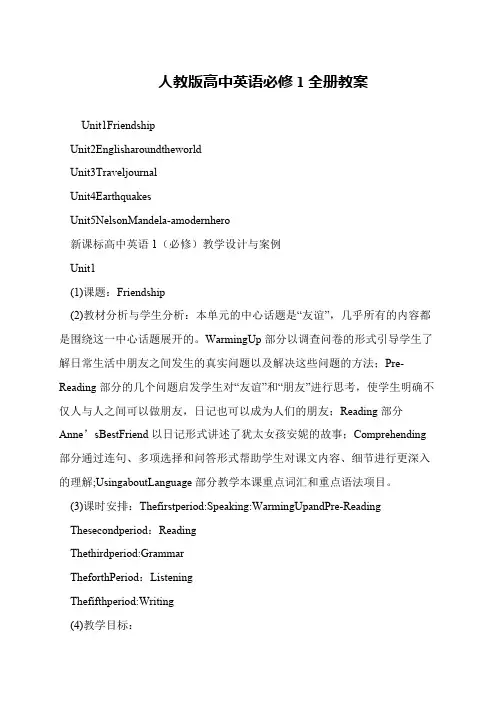
人教版高中英语必修1全册教案
Unit1Friendship
Unit2Englisharoundtheworld
Unit3Traveljournal
Unit4Earthquakes
Unit5NelsonMandela-amodernhero
新课标高中英语1(必修)教学设计与案例
Unit1
(1)课题:Friendship
(2)教材分析与学生分析:本单元的中心话题是“友谊”,几乎所有的内容都是围绕这一中心话题展开的。
WarmingUp部分以调查问卷的形式引导学生了解日常生活中朋友之间发生的真实问题以及解决这些问题的方法;Pre-Reading部分的几个问题启发学生对“友谊”和“朋友”进行思考,使学生明确不仅人与人之间可以做朋友,日记也可以成为人们的朋友;Reading部分Anne’sBestFriend以日记形式讲述了犹太女孩安妮的故事;Comprehending 部分通过连句、多项选择和问答形式帮助学生对课文内容、细节进行更深入的理解;UsingaboutLanguage部分教学本课重点词汇和重点语法项目。
(3)课时安排:Thefirstperiod:Speaking:WarmingUpandPre-Reading
Thesecondperiod:Reading
Thethirdperiod:Grammar
TheforthPeriod:Listening
Thefifthperiod:Writing
(4)教学目标:。
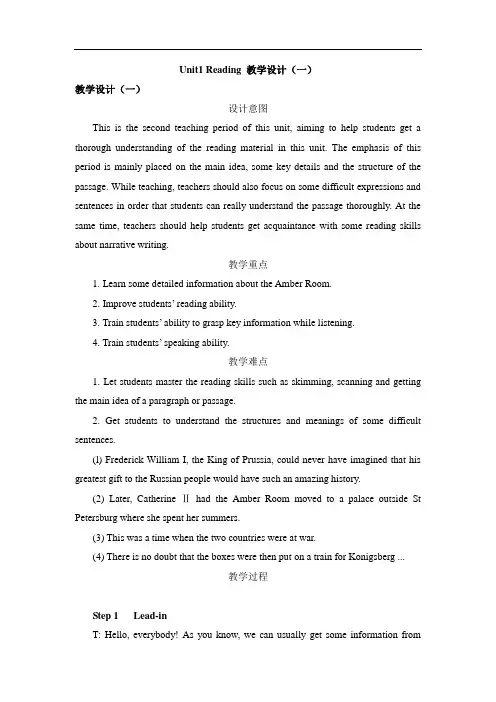
Unit1 Reading 教学设计(一)教学设计(一)设计意图This is the second teaching period of this unit, aiming to help students get a thorough understanding of the reading material in this unit. The emphasis of this period is mainly placed on the main idea, some key details and the structure of the passage. While teaching, teachers should also focus on some difficult expressions and sentences in order that students can really understand the passage thoroughly. At the same time, teachers should help students get acquaintance with some reading skills about narrative writing.教学重点1. Learn some detailed information about the Amber Room.2. Improve students’ reading ability.3. Train students’ ability to grasp key information while listening.4. Train students’ speaking ability.教学难点1. Let students master the reading skills such as skimming, scanning and getting the main idea of a paragraph or passage.2. Get students to understand the structures and meanings of some difficult sentences.(l) Frederick William I, the King of Prussia, could never have imagined that his greatest gift to the Russian people would have such an amazing history.(2) Later, Catherine Ⅱhad the Amber Room moved to a palace outside St Petersburg where she spent her summers.(3) This was a time when the two countries were at war.(4) There is no doubt that the boxes were then put on a train for Konigsberg ...教学过程Step 1 Lead-inT: Hello, everybody! As you know, we can usually get some information frompictures. Please look at the pictures and use the words in Unit 1 to describe them. (Students give their answers.)Can you imagine building a room using amber? Today we will get to know a mysterious amber room. Now watch a short VCR to get some brief information.Step 2 Reading1. SkimmingT: Read the text quickly, trying to get the main idea about the text.It tells us the strange history of the ,a cultural relic of two countries: and .T: Have you finished? If you find the answer, please put up your hand. Now let’s check up the answer.S1: Amber Room, Germany and Russia.T: Excellent. OK, class, just now you found out some simple facts about the text. Read the pas-sage quickly and. find out the main idea of each paragraph.Para.1: The Amber Room and itsParagraphs 2~3: of the Amber RoomPara.4: of the Amber RoomPara.5: of the Amber RoomT: Have you got the answers?Ss: Yes.T: All right. Tell me your answers.Ss: Para. 1: designParagraphs 2~3: The historyPara.4: The missingPara.5: The rebuilding2. ScanningA. Read through the text and decide whether the following statements are true or false.1. The Amber Room, which was a great work of art, was originally (起初) made to be a gift to the Russian people. ( )。
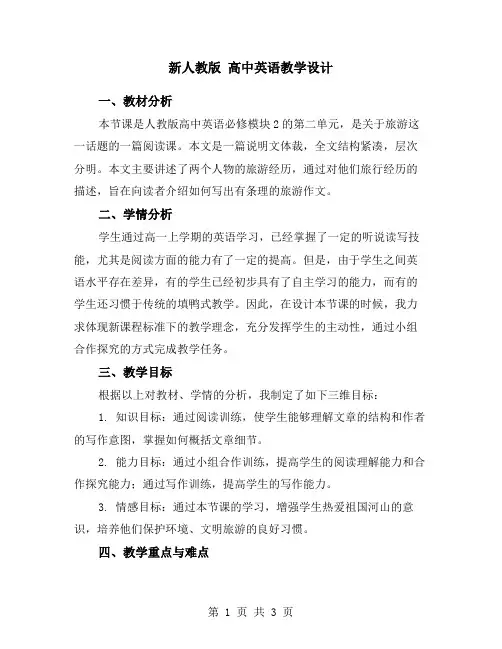
新人教版高中英语教学设计一、教材分析本节课是人教版高中英语必修模块2的第二单元,是关于旅游这一话题的一篇阅读课。
本文是一篇说明文体裁,全文结构紧凑,层次分明。
本文主要讲述了两个人物的旅游经历,通过对他们旅行经历的描述,旨在向读者介绍如何写出有条理的旅游作文。
二、学情分析学生通过高一上学期的英语学习,已经掌握了一定的听说读写技能,尤其是阅读方面的能力有了一定的提高。
但是,由于学生之间英语水平存在差异,有的学生已经初步具有了自主学习的能力,而有的学生还习惯于传统的填鸭式教学。
因此,在设计本节课的时候,我力求体现新课程标准下的教学理念,充分发挥学生的主动性,通过小组合作探究的方式完成教学任务。
三、教学目标根据以上对教材、学情的分析,我制定了如下三维目标:1. 知识目标:通过阅读训练,使学生能够理解文章的结构和作者的写作意图,掌握如何概括文章细节。
2. 能力目标:通过小组合作训练,提高学生的阅读理解能力和合作探究能力;通过写作训练,提高学生的写作能力。
3. 情感目标:通过本节课的学习,增强学生热爱祖国河山的意识,培养他们保护环境、文明旅游的良好习惯。
四、教学重点与难点教学重点:通过阅读训练,使学生能够概括出文章细节;通过写作训练,使学生能够写出有条理的旅游作文。
教学难点:如何引导学生理解作者的写作意图;如何引导学生写出有自己观点的作文。
五、教学方法与手段在本节课中,我将采用以下两种教学方法和教学手段来辅助教学:1. 任务型教学法:通过一系列的任务设计,引导学生完成阅读和写作任务,培养学生运用英语进行交际的能力。
2. 情景创设法:利用多媒体手段创设情境,激发学生的兴趣和求知欲,提高课堂教学效果。
3. 合作学习法:通过小组合作探究的方式完成教学任务,充分发挥学生的主动性。
六、教学过程设计Step 1: Pre-reading (5mins)首先,我利用多媒体展示一些有关旅游的图片和视频,激发学生的兴趣和求知欲。
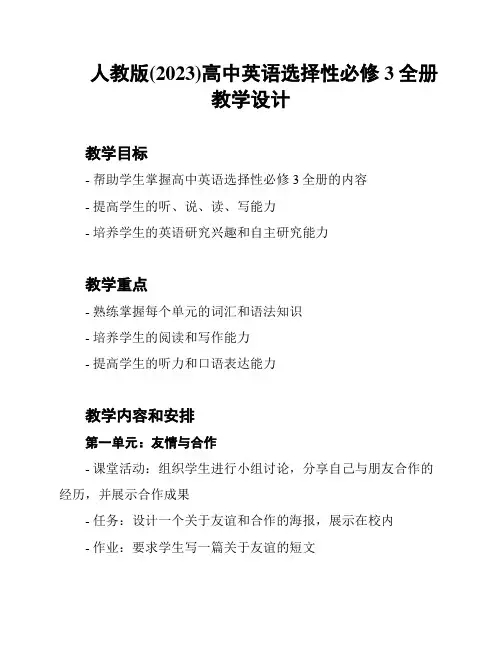
人教版(2023)高中英语选择性必修3全册教学设计教学目标- 帮助学生掌握高中英语选择性必修3全册的内容- 提高学生的听、说、读、写能力- 培养学生的英语研究兴趣和自主研究能力教学重点- 熟练掌握每个单元的词汇和语法知识- 培养学生的阅读和写作能力- 提高学生的听力和口语表达能力教学内容和安排第一单元:友情与合作- 课堂活动:组织学生进行小组讨论,分享自己与朋友合作的经历,并展示合作成果- 任务:设计一个关于友谊和合作的海报,展示在校内- 作业:要求学生写一篇关于友谊的短文第二单元:人与自然- 课堂活动:观看相关纪录片,让学生了解人与自然之间的关系,并进行讨论- 任务:组织学生参与环保行动,例如清理校园垃圾等- 作业:要求学生写一篇关于环境保护的文章第三单元:科技与进步- 课堂活动:分组进行辩论,讨论科技对人类生活的影响和挑战- 任务:组织学生进行科技创新展示,展示自己的科技产品或创意- 作业:要求学生写一篇关于科技发展的短文第四单元:文化与传统- 课堂活动:学生展示自己所在地区的传统文化,分享并讨论文化差异- 任务:组织学生进行文化体验活动,例如品尝传统食物、制作手工艺品等- 作业:要求学生写一篇关于自己民族文化的介绍第五单元:教育与就业- 课堂活动:邀请校外的教育专家或企业代表进行讲座,讨论教育和就业话题- 任务:组织学生进行职业规划,制定个人研究计划和职业发展目标- 作业:要求学生写一篇关于职业选择的小论文第六单元:社会与责任- 课堂活动:组织学生进行社会实践活动,例如参观社区组织、义务劳动等- 任务:组织学生进行社会调查,了解和分析现实社会问题- 作业:要求学生写一篇关于社会责任的短文教学评估- 组织学生进行课堂小测、作业评分和口头表达评估- 鼓励学生进行自评和互评,形成良好的研究氛围和反思惯教学资源- 人教版(2023)高中英语选择性必修3教材- 多媒体设备和纸质教材辅助资料- 网络资源和相关视频资料教学辅助措施- 配备合适的教学设备和教学软件,以提高教学效果和学生参与度- 鼓励学生积极参与课堂活动和讨论,激发他们的研究兴趣和主动性教学反思与调整- 定期进行教学反思,根据学生的研究情况和反馈,及时调整教学计划和教学方法- 鼓励学生提出意见和建议,以不断改进教学质量和效果。

高中英语优秀教学设计(优秀10篇)高中英语教学设计篇一1、知识目标学生能够会说、认读本课对话并能够使用句型:What are you doing? I’m making a model ship。
Pass me an egg,please。
Give me two apples。
2、能力目标引导学生积极运用所学英语进行表达与交流,学生的多元化只能在交际活动中得以以体现和发展3、情感目标把语言训练融入各种情景之中,学生通过体验,参与活动,学会与他人合作,共同完成学习任务,从而体验成功,培养对语言学习的兴趣。
4教学重难点重点:1)理解并灵活运用句型What are you doing? I’m…2)两个祈使句:Pass me an egg,please。
Give me two apples。
难点:knife、scissors、minute的发音。
以及长句子:We‘ll goto the lake and try it on the water。
5、教具准备课件、录音机和磁带,剪刀,小刀,一页纸,图片等方案设计方法基于本课的特点和六年级学生好动,好奇,模仿力强,表现欲旺盛等心理特点,我在教法设想和学法指导上坚持以情景话题为核心,以功能、结构为主线,以任务型活动贯穿教学始终,运用直观教学法,情景教学法,全身反应法等教学方法,帮助学生在视听说读唱玩演等饶有趣味活动中,相互合作,体验参与,自主的、愉快的学习英语,发展能力,维持兴趣。
力求做到:“开课能激趣,讲课蕴情趣,练习有兴趣,结束藏意趣”教案流程1、 Warm up(1) Greetings师生相互问候,帮助学生自然进入英语学习状态(2) Sing a song and dance: Front,back,right ,left师生共同唱歌跳舞,既活跃课堂氛围,拉进师生间距离。
2、 Revision让学生两人一组复习第18课的会话,为下一步学习作了铺垫。
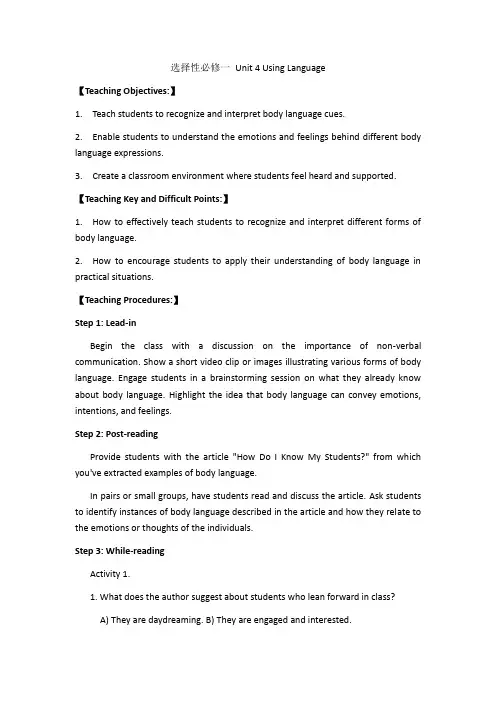
选择性必修一Unit 4 Using Language【Teaching Objectives:】1.Teach students to recognize and interpret body language cues.2.Enable students to understand the emotions and feelings behind different body language expressions.3.Create a classroom environment where students feel heard and supported.【Teaching Key and Difficult Points:】1.How to effectively teach students to recognize and interpret different forms of body language.2.How to encourage students to apply their understanding of body language in practical situations.【Teaching Procedures:】Step 1: Lead-inBegin the class with a discussion on the importance of non-verbal communication. Show a short video clip or images illustrating various forms of body language. Engage students in a brainstorming session on what they already know about body language. Highlight the idea that body language can convey emotions, intentions, and feelings.Step 2: Post-readingProvide students with the article "How Do I Know My Students?" from which you've extracted examples of body language.In pairs or small groups, have students read and discuss the article. Ask students to identify instances of body language described in the article and how they relate to the emotions or thoughts of the individuals.Step 3: While-readingActivity 1.1. What does the author suggest about students who lean forward in class?A) They are daydreaming. B) They are engaged and interested.C) They are angry or afraid. D) They are distracted.2. According to the article, why might a student hide their face in their hands?A) They are embarrassed or ashamed. B) They are excited about the lesson.C) They want to avoid eye contact. D) They are happy.3. Why does the author emphasize the importance of reacting to body language in the classroom?A) To make students uncomfortable. B) To assess students' academic abilities.C) To create a supportive learning environment.D) To encourage students to speak more in class.Activity 2. Present a list of common body language cues (e.g., eye contact, facial expressions, posture, gestures). Discuss each cue's meaning and how it can vary in different contexts.Activity 2. Show images or short video clips of people exhibiting various forms of body language. Have students analyze and interpret the body language cues in these examples.Step 4: Post- readingActivity 1. Provide students with real-life scenarios (e.g., job interviews, social interactions, classroom situations). In pairs or small groups, have students role-play these scenarios while paying attention to their body language. Encourage peer observation and feedback on body language cues during role-play.Activity 2. Lead a class discussion on the importance of empathy in understanding others. Discuss how recognizing body language can lead to more empathetic communication. Have students share their insights and experiences on how body language affects their daily interactions.【Homework Assignment】Assign students to observe and record instances of body language in their daily lives.Have them reflect on how recognizing body language influenced their interactions.Encourage students to write a short reflection essay or share their experiences in the next class.。
高中英语优秀教学设计5篇教学设计一:阅读理解策略教学目标:1. 学生能够运用预测、略读、寻读等阅读策略提高阅读效率。
2. 学生能够准确理解文章主旨大意,并能识别文章中的细节信息。
3. 学生能够分析作者的观点和态度,并进行批判性思考。
教学步骤:1. 导入:通过讨论学生感兴趣的话题引入阅读材料,激发学生的阅读兴趣。
2. 略读:指导学生快速浏览文章,了解文章的大致结构和内容。
3. 寻读:引导学生根据问题寻找文章中的关键信息,提高寻找信息的速度和准确性。
4. 精读:组织学生仔细阅读文章,理解文章的细节信息,并分析作者的观点和态度。
5. 讨论:组织学生就文章内容进行讨论,分享自己的观点和感受,培养学生的批判性思维能力。
教学反思:本节课通过引导学生运用阅读策略,提高了学生的阅读效率和理解能力。
在今后的教学中,可以进一步引导学生将阅读策略应用于其他类型的文本,以提高学生的综合阅读能力。
教学设计二:写作技巧训练教学目标:1. 学生能够掌握议论文的基本结构和写作技巧。
2. 学生能够运用论据和论点进行有效的论证。
3. 学生能够进行自我修改和同伴互评,提高写作水平。
教学步骤:1. 导入:通过分析优秀议论文,引导学生了解议论文的基本结构和写作技巧。
2. 写作指导:讲解议论文的写作步骤,包括确定论点、寻找论据、组织文章结构等。
3. 实践练习:组织学生进行写作练习,并鼓励学生运用所学技巧进行创作。
4. 同伴互评:引导学生进行同伴互评,互相提出修改建议,提高写作水平。
5. 自我修改:指导学生根据同伴互评和自我反思进行修改,完善文章。
6. 展示与分享:组织学生展示自己的作品,并分享写作心得和体会。
教学反思:本节课通过讲解写作技巧和实践练习,提高了学生的写作能力。
在今后的教学中,可以进一步引导学生关注写作过程中的细节问题,如语法、拼写、标点等,以提高学生的写作质量。
教学设计三:口语交际能力提升教学目标:1. 学生能够运用恰当的口语表达技巧进行日常交流。
高中英语优秀教学设计3篇(人教版高中英语教学设计优秀案例)下面是收集的高中英语优秀教学设计3篇(人教版高中英语教学设计优秀案例),以供借鉴。
高中英语优秀教学设计1一、教材分析:本课是结合人教版高中英语教材选修5中有关过去分词的语法内容,进行过去分词的学习,教学中将语法知识的传授和语言基本技能的学习结合到一起,注重复习语法与语言的运用。
采用任务型教学法和小组合作探究学习法,从而扩大课堂的语言输入量及学生的语言输出量。
二、学情分析:在高一英语学习基础上,学生已经掌握基本的语言结构和一定程度的听说读写能力。
在复习的过程中,结合学生原有的知识掌握水平,巩固基础强化正确使用语法知识,提高学生运用语言的深度和难度.但大部分学生的基础知识仍然较为薄弱,运用英语进行交际活动的能力较差,主动学习的动力不够,然而他们学习比较认真,渴求知欲旺盛,思维比较活跃。
部分学生的基础较好,能主动配合老师。
只有设置使他们感兴趣的活动,因材施教,才能让他们投入到课堂活动中来。
三、教学目标:1.知识目标:引导学生掌握过去分词在真实的生活语境中的使用。
培养学生通读,分析,理解,综合的能力,教会学生体察语境,结合上下文,符和逻辑推理和合理的想象,结合语法和题干中的语境解决问题。
在运用语言过程中培养学生的观察力、分析力、想象力和自学能力,提高思维能力和运用英语的综合能力。
2.能力目标:利用多媒体手段营造积极和谐教学氛围,使学生进入情景之中,充分调动学生的思维活动和情感体验,规范学生运用英语知识准确表达的能力,同时,发展学生综合语言运用的能力,分析问题和解决问题的能力,培养学生自主学习。
3.德育目标:用含过去分词的句子结构表达思想感情。
四、教学重点:1.过去分词的用法.2. 过去分词的运用五、教学难点:1.结合语法知识,以课堂教学为依托,全面训练学生的听、说、读、写能力,加强和提高运用英语的综合能力。
2. 过去分词在真实的生活语境中的使用。
人教版高中英语必修一Unit 2 reading教学设计弦第一.教材本节课教材选取的是必修一第二单元阅读部分。
第二.教学目标1.语言目标●通过对单词的预习及听录音,能够熟读文章中出现的新单词。
●能够在讨论活动中用简单的英语发表自己的看法。
●掌握阅读基本技巧并予以运用。
2.情感目标●让学生认识到英语的重要性,激发学习热情。
●通过对英语发展过程的了解,培养他们的跨文化意识和世界意识。
●通过小组讨论培养团队合作意识。
第三.教学重点及难点●提高学生的阅读技巧——scanning 和 skimming。
由于学生刚从初中进入高中,对高中英语的阅读难度很难适应,因此迫切需要提高阅读技能。
这既是本节课的重点又是难点。
●能读懂文章,了解文章的基本大意及各段落大意。
学会快速找到每段的中心句。
●学会划出阅读理解题的关键词,并能在寻读过程中找到相关信息。
第四,教学过程Step1. Lead-in (6 minutes)课前放首英文歌(when you believe),为接下来的讨论提供信息。
问候完后问一个与学生实际相关的问题:How long have you learned English? 然后引出讨论话题:Why do so many people learn English? 两人一组进行讨论,用短语尽可能多的说出原因。
可在黑板上举个例子:To listen to the English songs,同时写出课前歌曲名字。
两分钟讨论后,让学生给出答案,幻灯片如下展示:然后再问学生:How much do you know about the English language? 再进入本课主题:the road to modern English.Step 2: Pre-reading (3 minutes)用三幻灯片预习本文中的生单词及短语,为阅读扫清障碍。
(对于许多没有做预习的学生来说,这一步是非常有必要的。
选择性必修一Unit 3 Using Language【Teaching Objectives:】1.Enable students to identify key information about different theme parks and their attractions.2.Develop students' comprehension skills by extracting main ideas and supporting details.3.Enhance students' cultural awareness by understanding the significance of theme parks in different regions.4.Encourage critical thinking and reflection on personal preferences and interests in entertainment.【Teaching Key and Difficult Points:】Developing students' ability to distinguish main ideas and supporting details.Encouraging students to analyze the cultural significance of theme parks.【Teaching Procedure:】Step 1. Warming Up:Begin with a class discussion about theme parks. Ask students if they have ever visited a theme park and which ones they are familiar with. Share some pictures and videos about theme parks to arouse students' interest and curiosity.Step 2. Pre-Reading:Display the title of the article, "Theme Parks: Fun and More Than Fun," and ask students to predict what the article might be about based on the title.Step 3. While-Reading:Activity 1. Assign students to read the article individually. After reading, have a class discussion to summarize the main theme parks mentioned in the article and their unique attractions.Activity 2. Prepare a list of key theme parks mentioned in the article along with their main features. Divide the class into small groups and provide each group with a set of theme park names and descriptions.Main Features1. : Magical world, childhood dreams come true, space travel, pirate ship, fairytale and cartoon characters, exciting rides, parades.Main Features2: Celebrates traditional southeastern culture, country music performances, skilled workers showcasing old-fashioned crafts, historical candy shop, wooden roller coaster.Main Features3: Leading ocean-themed park, Whale Shark Aquarium, dolphin and sea lion shows, diverse animals including polar bears, water rides, Journey of Lights Parade, fireworks.In a timed activity, have groups match the correct theme park with its description. Review the answers as a class and discuss why each theme park might appeal to different types of visitors.Activity 3. Discuss with students the cultural aspects highlighted in the article. For example, how does Dollywood celebrate America's traditional southeastern culture? How does Disneyland bring childhood dreams to life? Ask students to reflect on the role of theme parks in preserving cultural heritage and offering entertainment.Step 4. Post-readingAsk students to imagine they have the opportunity to create their own theme park based on their interests and preferences. Have them describe the key attractions, rides, and cultural elements they would include in their dream theme park. Encourage students to think about what makes their theme park unique and appealing to visitors.Then assign students to work individually or in pairs to create a brochure for their dream theme park. The brochure should include enticing descriptions, images, and highlights of the attractions and cultural experiences offered in their imagined theme park.Reflection and Homework: Theme Park Analysis:Assign students to choose one of the theme parks discussed in the article (Disneyland, Dollywood, or Chimelong Ocean Kingdom) and write a short reflection on why they would like to visit that particular theme park.Students should consider the attractions, rides, cultural elements, and theirpersonal interests when explaining their choice.。
新人教版高中英语必修一教学设计一、教学任务及对象1、教学任务本次教学任务是基于新人教版高中英语必修一的内容进行设计。
本教材以提升学生的英语综合运用能力为主要目标,围绕不同的主题,培养学生听、说、读、写四项基本技能。
在教学过程中,我将重点关注学生对英语语法、词汇、句型的掌握,以及在实际语境中运用英语进行交流的能力。
此外,通过丰富多样的教学活动,激发学生的学习兴趣,使他们形成良好的学习习惯,为今后的英语学习打下坚实基础。
2、教学对象本次教学设计的对象为高中一年级学生。
他们已经在初中阶段学习了英语基础知识,具备一定的英语听说读写能力。
然而,由于学生的英语水平参差不齐,教学中需要充分考虑个体差异,因材施教。
此外,高中阶段的学生正处于青春期,具有强烈的求知欲和好奇心,但同时也可能存在一定的叛逆心理。
因此,在教学中,教师需要关注学生的心理变化,采用适当的教学策略,调动他们的学习积极性,引导他们形成正确的价值观。
二、教学目标1、知识与技能(1)掌握新人教版高中英语必修一的全部词汇、短语和基本句型,能熟练运用所学知识进行日常交流;(2)提高学生的英语阅读能力,能够理解并分析文章的主旨、大意、细节和结构,提高阅读速度;(3)培养学生英语写作能力,能够根据给定的话题进行有逻辑、有条理的写作;(4)提高学生的英语听力水平,能够理解并掌握教材中听力材料的要点,并能进行简单的口头复述;(5)通过口语表达训练,使学生能够自信、流畅地运用英语进行口头表达,增强英语实际运用能力。
2、过程与方法(1)采用任务型教学法,设计丰富多样的教学活动,让学生在实践中学习英语;(2)运用合作学习法,鼓励学生之间相互交流、讨论,共同解决问题,提高学生的团队协作能力;(3)采用启发式教学法,引导学生主动思考,培养学生的自主学习能力和探究精神;(4)注重个体差异,因材施教,针对不同水平的学生制定合适的学习任务和目标;(5)运用多媒体教学手段,创设生动、直观的英语学习情境,激发学生的学习兴趣。
Listening and Speaking
(2)学生选择活动5中的情境,用整理后的语言结对编对话。
(3)学生谈论自己身边将要进行的体育赛事或活动,并邀请朋友参加。
教学提示:教师还可以根据当地特色,让学生选择其他运动项目作为素材,这也是引导学生归纳、总结已知的运动项目名称词的好机会。
本单元练习册中有意增加了对冬奥会项目的介绍,目的是引导学生关注冬奥会,借以普及冬奥会知识。
Step 5 Pronunciation
(1)学生自主朗读对话,体会对话中附加疑问句的语调。
(2)学生在小组内交流,讨论对话中附加疑问句的语调,重点讨论为什么用升调或降调,并总结出什么时候用升调,什么时候用降调。
附加疑问句用升调和降调的基本知识:一般情况下,如果提问者已经知道问题的〖答案〗,只是想强调该〖答案〗或仅仅是为了加强语气,那么其使用的附加疑问句用降调;如果提问者本身不知道问题的〖答案〗,或是由于不太肯定而想作进一步的确认,那么其使用的附加疑问句用升调。
升调和降调是英语中两种最基本的语调。
英语与汉语不同,英语是通过句子语调和重音形成自己独特的节奏,但在实际运用中,语调可以根据所要表达的语义和情感进行变通,用不同的语调说同一个句子可以表达不同的含义。
(3)学生听录音,核对自己所使用的语调是否符合对话场景,并模仿录音跟读。
(4)学生结对,使用恰当的语音、语调练习对话,完成口语输出。
人教版高中英语必修三 unit 2 healthy eating教学设计(一)教学内容分析这是一篇介绍“饮食习惯”的文章,包括传统饮食习惯的改变日常饮食选择,旨在让学生明白健康的饮食习惯的养成是拥有健康体魄的前提。
本篇文章生词量较大标题较抽象,各段主题句分布不太明显(大部分分布在段落中间)。
且大部分学生对饮食与健康的关系(如人体每天必须摄入的六种基本营养成分的来源、健康饮食的重要性、什么是绿色食品等)了解较少。
因此,本文的学习难度较大。
(二)教学目标1. 语言知识目标:a)使学生了解protein, calcium等基本营养成分的来源和主要功能,健康的饮食习惯是健康的保证,以及素食主义等信息。
b)学习掌握有关营养成分与食物的词汇,如:protein、calcium 、carbohydrate 、fibre、mineral、 vitamin 、vegetarian & vegan、 green food and clean food 、eco-food and organic food等,以及 keep up with ,the same goes for?以及as 和only 引导的倒装句的用法。
2. 语言技能目标:a)使学生学会克服生词障碍,通过略读,寻找文章的主题句,理清文章的总体框架与脉络;通过查读,捕捉文章的重要细节,理解作者的写作意图。
b) 使学生学会运用各种猜词技巧,猜测部分生词在具体的语言环境的含义。
c) 使学生能够运用所学知识,用英语为自己所熟悉的一个人设计一份“healthy diet”,并阐明设计的依据。
3.情感态度与文化意识目标:a)使学生学会审视自己、审视食物,提高养成健康饮食习惯的意识。
b)使学生懂得:健康是做好一切事情的根本。
要想有强健的体魄,除了合理安排好一天的生活以外,还需要有科学、卫生的饮食习惯,每天一定量的体育活动和体力劳动。
青少年必须有健康的身体,长大以后才能成为一位具有现代科学文化,适合时代要求的合格劳动者。
c)使学生学会关心他人,体贴他人,并养成较强的合作意识。
d)让学生了解一些不同的饮食观念及主张,加深对世界饮食文化的了解,弘扬中华民族饮食文化的精髓,培养爱国主义精神。
(三)教学重点和难点:1.重点1)让学生认识到饮食对健康的重要影响。
2)侧重培养学生对文章的整体性结构的把握,突出培养学生以下3个方面的能力:a.文章中心把握能力。
b.根据主题快速捕捉文章重点细节的能力。
c.猜词能力。
3)重点掌握有关营养成分与食物的词汇,特别是人体每天必须摄入的六种基本营养成分的词汇以及这些营养成分的来源和主要功能。
2.难点1) 如何使学生养成科学的阅读习惯,提高阅读理解能力和语言水平。
2) 如何使学生学会提取、筛选和重组文章中关于健康饮食的信息,并灵活运用于语言实践中,达到语言实践能力的扩展与提高。
二、教学方法与教材处理1.任务型语言教学法任务型语言教学认为:人们使用语言的过程就是一个完成各种各样任务的过程。
任务型学习强调通过“做中学”、“学中做”,使学生在完成任务的过程中习得语言。
本课组织学生四至五人组成一个学习小组,共同为大家所熟悉的一个人设计一份“healthy diet”, 并口头阐述设计的理由。
该设计基于课文内容,但又不局限于课文的范畴,旨在贯彻“做中学”、“学中做”策略,吸引和组织他们积极参与,并通过讨论、交流和合作等方式,在自然、真实的情境中,完成任务,体会、掌握语言的应用,达到学以致用的目的。
2.合作学习教学法合作学习教学法是以小组活动为主体的一种教学活动,一种同伴之间的合作互动活动,。
合作学习教学法有利于改善课堂心理气氛、大面积提高学生的学业成绩、促进学生良好非智力品质的发展,调整学生的语言焦虑感。
焦虑是影响外语学习的重要情感因素,外语学习中的焦虑主要是指学习者需要用外语进行表达时产生的恐惧或不安心理。
因此,本课打破传统的“稻田式课堂教学结构”采用“四至五人组成一个学习小组”的课堂教学结构,来组织教学,旨在营造轻松的学习氛围,为积极学习提供有利的条件,让学生在完成任务的过程中通过互相交流,降低语言焦虑感,获得愉快的学习经历,从而对学习本身和所学内容产生兴趣感。
3.整体语言教学法整体语言教学法要求按“整体-部分-整体”的模式,进行语篇阅读训练,即从“整体”开始,以“整体”结束的“三段式”阅读教学法。
本课采用从整体略读——分段细读——听读课文内容,进一步理解课文内容,即是这种教学策略的体现。
(四)、学法指导1)认知策略:指导学生运用已学会的抓重点、做记号、摘笔记等方式,对所学内容进行整理与归纳。
2)调控策略:继续培养自我评价与相互评价的习惯,鼓励学生增加与教师和同学交流学习英语的体会和经验,学会科学评价自己的学习行为与学习效果,进一步形成有效的学习方法,树立积极向上的学习态度。
3)交际策略:创设有意义的情景和任务活动,引导学生通过四人一小组,进行合作学习,让他们围绕课堂任务分工合作,相互探讨、相互交流,从而获得知识、技能和情感体验,变被动学习为主动学习。
(五)、说教学程序1.pre-task:激发学习兴趣,明确学习任务(8分钟左右)引入话题,激发学习兴趣,明确学习任务。
教师通过一个问题“ do you think it important to have good eating habits?”呈现文章的标题“we are what we eat”。
紧接着引导学生解读文章标题、预测文章内容,让学生在阅读过程中处于主动认知状态。
虽然本文标题较抽象, 学生可能一下子无法正确理解其所包含的深层含义,可再采取通过分析句子成分和引导学生抓住关键词“eat”进行大脑风暴两种方式相结合的教学策略来降低理解难度。
考虑到文章生词量较多,且大部分学生对文章的背景知识,了解较少。
因此,在引导学生预测文章内容的同时,有必要在讨论“what kind of words will be used in the passage?”这个问题时,引出人体每天必须摄入的六种基本营养成分的单词:protein、calcium 、carbohydrate 、fibre、 mineral、 vitamin 。
这样既可向学生展示本环节的重点单词,又可为阅读扫清文化背景障碍和语言障碍,又可为突破本文的重难点作好准备。
2.task-cycle:课文主体内容的教学与操练,知识的掌握与能力的过渡(27分钟左右)指导学生根据不同的阅读目的,在阅读的不同阶段,灵活使用各种阅读策略,捕捉文章主要信息,理解作者的写作意图,突破本文的教学重点与难点。
1.通过限时阅读训练,引导学生略读文章内容,归纳段落大意,理清全文线索,侧重培养快速阅读理解能力和文章中心把握能力。
【设计思路】:本环节针对课文的主旨,提出两个预测性问题,要求学生在5分钟之内,略读文章内容,快速找出各段的key sentence,理清文章的基本脉络。
在两个预测性问题的帮助下,大部分学生很快就能找出文章的主题句,理解作者的写作意图。
针对各段主题句分布不太明显,学生寻找起来有一定的难度这一情况,教师可通过先展示文章基本脉络,提醒学生根据文章脉络以及对文章主旨的把握,结合自己在阅读之前对文章的预测,快速找出各段的key sentence,归纳各段大意。
此外,教师还应通过限定阅读时间,及时纠正不良的阅读习惯等教学策略,来帮助学生养成良好的阅读习惯,培养快速阅读理解能力。
2.精读部分语段,侧重培养快速捕捉文章重要细节的能力和猜测生词的能力。
【设计思路】:本文的主要生词和重点细节主要集中在第二至第四段(特别是第二段材料)。
因此,可引导学生通过查读第二段材料,找出人体每天必须摄入的六种基本营养成分及其来源和功能。
此外,考虑到这六个词汇的知识含量较高,且难于记忆,故笔者在设计上作了一个小小的创新。
即以表格的形式,让学生填写本文的重点细节,让学生在完成任务的过程中,体会各种营养成分来源的规律,为学会给未提及的食物作营养成分推测,培养信息归类能力,作好铺垫。
然后再通过直观手段,以图片结合文字的形式,再次展现文章的重点单词与细节,激发学习兴趣,加深学生的印象,并为突破本文的重点与难点:“design a healthy diet and list your reasons.”打下扎实的基础。
相对于第二段材料,第三段和第四段材料的生词量较少,且大部分生词通过使用各种猜词策略,就可理解他们在文中的意思。
因此,可充分利用这两段内容,来培养学生的猜词悟义能力。
具体可引导学生先通过推读生词所在语段,然后再以小组为单位,交流各自所使用的猜词技巧与猜词经验,来提高培养学生的猜词能力,最终获得独立自由阅读的能力。
根据对教材内容的科学分析,确定本环节主要引导学生使用各种猜词策略(通过上下文、课文线索、词的形式、以及根据自己已有的知识等),猜测、理解“vegetarian”、“vegan”、“eco-food”、“organic food”、“green food and clean food”、“diet”、“supplement”等词在文中的意思。
同时为加深学生对“green food”的理解,还特地引出绿色食品的标志。
此外,还可在这一环节中适当处理一些语言难点(如 keep up with ,the same goes for ?及only 和as 引导的倒装句的用法),以上语言难点在 sb p131- p133 中,有详细的分析。
因此,课堂上不必占用太多时间,应把重点放在引导学生学会在具体的语境中理解、体会这些词组、句型的用法。
其它的一些语言难点可随机处理,也可通过练习的方式体现出来,让学生去课文中寻找答案,体会他们的用法。
3.post-task:展示成果,交流成果的过程,语言实践能力的扩展与提高(9分钟左右)采用交际教学法和合作学习法,组织语言实践活动,完成本文的主题任务。
达到从知识的巩固与运用到知识的扩展与创新能力的形成。
【设计思路】:本环节要求学生根据自己对健康饮食的认识,发挥自己的想象力和创造力,以小组为单位,用英语为大家所熟悉的某一个人(如:自己或班上的其他同学或者本校的某位老师)设计一份“healthy diet”, 并列出设计的依据。
由于pre-task 和 task-recycle 两个步骤中的许多活动,已从各个方面,为学生顺利完成本活动作好了充分的准备,故学生完成这个任务的难度,估计不大。
但为了更好地调动学生完成任务的积极性,本环节还特地以生动有趣的gif 动画和图片为学生提供了food groups。
针对主题任务,本环节还设计了小组间的设计成果竞赛与小组间的互相评价两个让学生互相交流学习成果的平台。